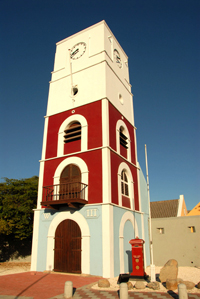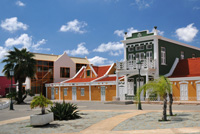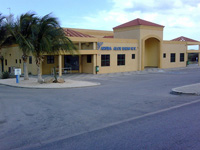Fort Zoutman & Historical Museum
Cruise passengers can walk through both ancient and modern history in downtown Oranjestad. Fort Zoutman, the oldest building, was completed in 1798 when Aruba was still frequented by pirates. As a means of defense, Governor Lauffer built a fort, named after a Dutch rear admiral, with a strategic view of the sea.
The tower, adorned with the first public clock, was added in 1868. The tower also served as a lighthouse, as it had a spire with a petrol lamp, which was first lit on King Willem III’s birthday in 1869, and subsequently named after him. The fort ultimately lost its significance as a means of defense, but commerce converted Oranjestad into the capital city and residence of the local government.
The Historical Museum in the fort houses a collection depicting the history and development of Aruba up to the 1920s when the LAGO oil refinery came to Aruba. Schools, tourists, and locals frequently visit the museum. The Bon Bini Festival, with dancing, arts and crafts stands, and local food, is held here every Tuesday evening at 6:30 pm. An engaging emcee introduces traditionally costumed folkloric dancers, local musical genres—like the mazurka and the waltz, and instruments.
Opening Hours:
Monday - Friday from 8:30 am until 4:00 pm. |
 |
The Archeological Museum
The Archeological Museum is located two blocks east of the Oranjestad bus station. The historic Ecury family complex is now a modern Archeological Museum. Great care has been taken to preserve the beauty and historic character of the original buildings.
The museum is devoted to Amerindian culture and archaeological finds from various digs around Aruba. The three periods of Amerindian habitation are documented: Pre-Ceramic period of 2500 BC – 1000 AD when semi-nomadic bands of Amerindians migrated from the South American mainland; the Ceramic Period of the Caquetio Indians, the hunters-fishers-gatherers who inhabited Aruba from 900 – 1515 AD until enslaved and taken to Hispaniola; and the Historic Period from 1515 – 1880 AD. The Amerindians left behind ornaments, shells, ceramics, amulets, and burial practices. There is a built-to-scale replica of a maloca hut of 1000 years ago, and the second floor is dedicated to cultural and religious practices.
Opening Hours:
Tuesday - Friday from 10:00am until 5:00pm,
Saturday and Sunday from 10:00am until 2:00pm.
Monday Closed
www.namaruba.org |


|
Aruba Aloe Museum & Factory
It’s hard to imagine that the same fields that the Aruba Aloe Museum & Factory use today have been in use for some 160 years. Since 1890—when farmers carefully planted the first aloe-vera plants— Aruba Aloe Balm has been in the business of growing and processing the Aruba aloe plant, and was one of the first companies in the world to make cosmetic products based on this curative gel. Today, the company proudly manufactures more than 50 different skincare and hair care products containing 100% pure Aruba aloe-vera gel.
Aruba Aloe products will surely come in handy while visiting the island, especially the line of sunscreen and sun-care products, which are FDA-approved. The new Dessert Bloom products make up the company’s aromatherapy line made with organic essential oils and aloe-vera gel.
Tour Schedule:
Monday until Friday from 8:30am until 4:00pm
Saturday from 9:00am until 12:00pm
Sunday Closed
FREE Entrance Fee
www.arubaaloe.com/factorymuseum.html |

|



